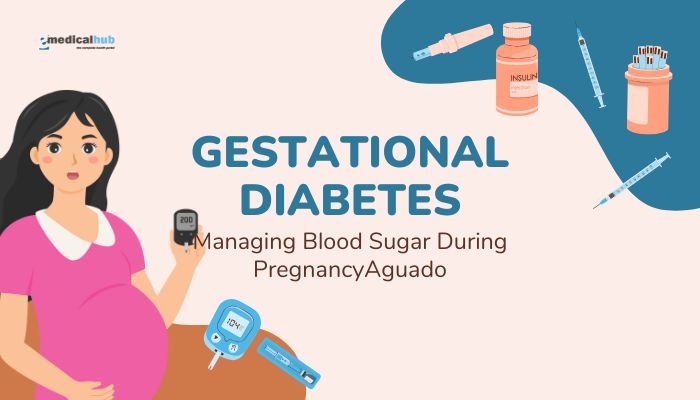Introduction
Gestational diabetes mellitus (GDM) is a form of diabetes first recognized during pregnancy. Characterized by higher-than-normal blood glucose levels, it arises from the body’s reduced capacity to process glucose due to hormonal changes and insulin resistance.
GDM typically appears in the second or third trimester, affecting around 5–10% of pregnancies worldwide. If not well-controlled, gestational diabetes can pose health risks for both mother and baby—however, with proper management, most women experience healthy pregnancies and deliveries.
Managing GDM involves frequent glucose monitoring, nutritional adjustments, balanced exercise, and sometimes medication. This article will explain the fundamentals of GDM, including risk factors, screening protocols, effects on both mother and child, and practical strategies for controlling blood sugar during pregnancy.
By understanding gestational diabetes and its care, expectant mothers can approach pregnancy with confidence and safeguard their health and that of their growing babies.
Understanding Gestational Diabetes
Definition and Distinctions
- Gestational Diabetes
Defined as glucose intolerance with onset or first recognition during pregnancy. Though it usually resolves postpartum, it signals a higher lifelong risk of developing type 2 diabetes for the mother, and in some cases, it can recur in subsequent pregnancies.
- Temporary but Critical
Unlike preexisting (type 1 or type 2) diabetes, GDM develops due to physiological insulin resistance that escalates as pregnancy hormones rise. Careful monitoring ensures glucose does not remain chronically elevated.
Pathophysiology
- Insulin Resistance
During pregnancy, the placenta produces hormones (like human placental lactogen, cortisol, progesterone) that help shift nutrients to the fetus. However, these also make maternal tissues less responsive to insulin.
- Pancreatic Compensation
In many women, the pancreas ramps up insulin production to overcome resistance. When this compensatory mechanism is insufficient, blood glucose rises.
- Glucose Transfer to Fetus
High maternal blood glucose crosses the placenta, spurring excess fetal insulin release and accelerated growth, leading to potential complications.
When and How It Develops
- Typical Onset
Usually after mid-pregnancy (24–28 weeks). Before that, gestational insulin resistance is less pronounced.
- Resolution
Often normalizes after delivery, as placental hormones disappear. But postpartum glucose checks are essential to catch persistent dysglycemia.
Key Takeaway: GDM is closely tied to the hormonal environment of pregnancy. Controlling blood sugar within safe ranges helps avoid short- and long-term health issues.
Risk Factors and Who Is Likely to Develop GDM
Major Risk Factors
- Obesity or Overweight: Higher BMI before pregnancy correlates with increased insulin resistance.
- History of GDM: A strong predictor that GDM might recur in subsequent pregnancies.Family History: Having close relatives with type 2 diabetes.
- Polycystic Ovary Syndrome (PCOS): Associated with insulin resistance, elevating GDM risk.
- Ethnic Background: Certain ethnic groups (e.g., South Asian, Hispanic, Black, Native American) display higher prevalence.
- Age Over 35: Risk intensifies as maternal age increases.
- Previous Large Baby: Delivering an infant over ~4,000–4,500 grams (9–10 lbs) suggests prior subclinical hyperglycemia.
Additional Considerations
- Excessive Weight Gain in Early Pregnancy: Heightening insulin resistance.
- Sedentary Lifestyle: Limited physical activity reduces insulin sensitivity.
- Multiple Gestation: Twins or triplets can intensify metabolic demands.
Screening and Diagnosis
Screening Methods
- 1-Step Approach (Common in Many Countries): A 2-hour 75 g oral glucose tolerance test (OGTT). Measurement of fasting, 1-hour, and 2-hour glucose levels.
- 2-Step Approach (Often in the U.S.):
- Step 1: Non-fasting 1-hour, 50 g glucose challenge test (GCT). If result surpasses a threshold (130–140 mg/dL), proceed to the next step.
- Step 2: 3-hour, 100 g OGTT with specific cutoffs for fasting, 1-hour, 2-hour, and 3-hour readings.
Timing of Screening
- Universal Screening: Typically performed at 24–28 weeks.
- Earlier Testing: For high-risk women (e.g., severe obesity, known insulin resistance, strong family history), screening may occur in the first trimester or repeated if initial results are normal but suspicion remains high.
Diagnostic Criteria (1-Step OGTT Example
Effects on Mother and Baby
Maternal Complications
- Preeclampsia: High blood pressure plus proteinuria can coincide with poorly controlled glucose.
- Birth Trauma: Larger babies increase risk of complicated vaginal deliveries, including perineal tears.
- Cesarean Delivery: Elevated chances if the fetus grows too large.
- Future Diabetes Risk: Many GDM mothers develop type 2 diabetes within ~5–10 years postpartum if lifestyle changes are not embraced.
Fetal and Neonatal Implications
- Macrosomia: Excess fetal insulin fuels adipose tissue growth, possibly leading to a larger-than-average baby.
- Neonatal Hypoglycemia: After birth, the baby’s pancreas may still overproduce insulin, leading to dangerously low blood sugars.
- Jaundice, Respiratory Distress: Higher risk if the baby is either too large or delivered preterm.
- Long-Term Child Health: Babies of GDM pregnancies could face a higher risk of obesity, glucose intolerance, or metabolic syndrome.
Blood Sugar Management: The Foundation of GDM Care
Target Glucose Ranges (General Guidelines)
- Fasting: <95 mg/dL
- 1-hour Postprandial: <140 mg/dL
- 2-hour Postprandial: <120 mg/dL
These targets may vary based on local or physician preferences, but typically revolve around these thresholds.
Self-Monitoring of Blood Glucose (SMBG)
- Frequency: Often four times daily (fasting plus 1 or 2 hours post-meals). Some may also check bedtime readings.
- Record Keeping: Logging values helps track patterns, adjust dietary or medication approaches.
- Continuous Glucose Monitoring (CGM): An option for some, providing real-time glucose insights.
Lifestyle at the Heart of Management
- Diet: Balanced carbohydrates, mindful portion sizes, timing of meals/snacks to prevent spikes or drops.
- Exercise: Even moderate activity (like walking) after meals can help lower glucose levels.
- Weight Gain Guidance: Follow recommended pregnancy gain based on BMI to limit insulin resistance escalation.
Nutrition and Meal Planning
Carbohydrate Management
- Complex Carbs: Focus on whole grains, legumes, vegetables, and fruits to maintain steadier glucose curves.
- Moderate Portions: Carbohydrate counting or consistent carb meals can help keep postprandial peaks under control.
- Spread Out Meals: 3 moderate meals plus 2–3 balanced snacks often avoid excessive fluctuations.
Balancing Macronutrients
- Protein: Lean meats, fish, eggs, dairy, or beans. Ensuring protein at each meal can stabilize post-meal glucose.
- Healthy Fats: Avocado, nuts, seeds, olive oil to slow carbohydrate absorption and support maternal health.
- High-Fiber Intake: Slows digestion, helps reduce post-meal spikes, and fosters satiety.
Meal Examples
- Breakfast: Oatmeal with berries, plus a boiled egg.
- Lunch: Chicken breast with quinoa and steamed vegetables.
- Dinner: Salmon with roasted non-starchy veggies.
- Snacks: Whole-grain crackers with cheese, Greek yogurt with cucumbers, or a small fruit portion with nuts.
Avoiding Sugary Drinks and Refined Carbs
- Beverages: Soda, sweet tea, fruit juice concentrate quickly raise glucose. Water, unsweetened tea, or infused water are better.
- Processed Snacks: Baked goods, white flour items, candy create rapid glucose surges—best to limit or portion carefully.
Exercise Recommendations
Benefits for GDM
- Insulin Sensitivity: Physical activity aids glucose uptake by muscles, reducing insulin requirements.
- Weight Control: Helps meet recommended pregnancy weight gain and reduces postpartum excess.
- Stress Relief: Alleviates some mental and emotional pressures of pregnancy.
Types of Safe Activities
- Walking: Gentle, low impact, easily adjustable intensity.
- Prenatal Yoga: Improves flexibility, breath control, and mental calm, with modifications for the belly.
- Swimming or Water Aerobics: Reduced strain on joints, good for advanced pregnancy.
- Stationary Cycling: Minimal fall risk, helps maintain stamina.
Frequency and Intensity
- Goal: ~150 minutes of moderate-intensity exercise weekly (e.g., 30 minutes, 5 days/week).
- Post-Meal Stroll: A 10–15 minute walk after meals can meaningfully lower postprandial peaks.
- Pregnancy Precautions: Avoid contact sports, high-risk falls, or supine positions after the first trimester to reduce venous return compromise.
Pharmacological Interventions
Oral Medications
- Metformin: Decreases hepatic glucose production and improves insulin sensitivity. Some practices find it safe and efficacious in pregnancy.
- Glyburide: Stimulates insulin secretion; can be used, but some prefer insulin or metformin due to concerns about maternal hypoglycemia or fetal exposure.
Insulin Therapy
- Gold Standard: Regarded as the most reliable in controlling GDM if lifestyle modifications are insufficient.
- Types: Long-acting insulin for basal coverage plus rapid-acting insulin at meals for postprandial control.
- Injection Safety: Typically subcutaneous. Adjusted based on daily glucose logs.
When Medication is Considered
- Persistent Elevated Glucose: If diet and exercise fail to achieve target levels within ~1–2 weeks.
- High Fasting Glucose: Often requires a basal insulin approach.
- Monitoring: Doses might be increased as pregnancy advances, since insulin resistance can worsen over time.
Potential Complications and Delivery Management
Labor and Delivery Issues
- Macrosomia: A large fetus might complicate vaginal delivery, raising risk of shoulder dystocia or requiring cesarean.
- Induction Timing: Some providers induce labor around 39 weeks if GDM is well-controlled or slightly earlier if concerns exist.
- Intrapartum Glucose Monitoring: Keeping maternal glucose stable during labor helps reduce neonatal hypoglycemia post-birth.
Neonatal Care
- Hypoglycemia: Babies born to mothers with high glucose environment can have high insulin levels at birth, prompting sharp glucose drops. They’re monitored carefully for the first 24–48 hours.
- Respiratory Maturity: If preterm birth is indicated, steroid shots might be given to accelerate lung development.
Postpartum Follow-up
- Blood Glucose Reassessment: A 6–12-week postpartum OGTT is recommended to check if glucose has returned to normal.
- Long-Term Surveillance: Women remain at higher risk for type 2 diabetes. Regular checkups (every 1–3 years) can catch early changes.
- Breastfeeding Encouragement: Aids maternal metabolic regulation and supports infant health.
Lifestyle and Mental Health During GDM
Stress and Emotional Burden
- Anxiety Over Food: Checking carbs and glucose can feel overwhelming. Balanced counseling helps.
- Guilt or Blame: Some mothers fear they caused GDM. Education clarifies that multiple physiological factors are at play.
- Support: Partners and family can help with meal prep, errands, or gentle exercise companionship.
Managing Cravings and Restrictive Diets
- Professional Nutrition Advice: A dietitian specialized in pregnancy can create individualized meal plans that allow a variety of tastes.
- Moderation: Occasional treat is possible if overall daily carbohydrate intake remains well-distributed.
Adherence to Monitoring
- Glucose Testing Fatigue: Checking multiple times a day can be stressful but is crucial for optimizing control.
- Tech Tools: Some prefer glucose meters with memory or apps to track results easily.
- Peer Support Groups: Online or local communities can share coping strategies.
Long-Term Health Implications
Reducing Future Diabetes Risk
- Healthy Weight Postpartum: Returning to a normal BMI if overweight can halve the future type 2 diabetes risk.
- Continued Balanced Diet: Maintaining stable eating habits begun during pregnancy fosters better metabolic health.
- Regular Exercise: Even postpartum walks or gentle workouts can keep insulin sensitivity up.
Impact on Future Pregnancies
- Higher GDM Recurrence: Rates can be as high as 30–70% in subsequent pregnancies.
- Pre-Pregnancy Counseling: Achieving normal weight, stable glucose (if borderline), and consistent physical activity before conceiving again is advantageous.
Summary and Takeaways
- Definition: Gestational diabetes emerges during pregnancy, primarily after 20 weeks, due to insufficient insulin to counter pregnancy-driven insulin resistance.
- Risk Factors: Overweight, family diabetes history, advanced maternal age, PCOS, certain ethnic backgrounds, among others.
- Screening: Typically done at 24–28 weeks via 1-step or 2-step OGTT; earlier if risk is high.
- Management: Cornerstones are dietary modification, regular physical activity, and, if required, medication (metformin, insulin).
- Goals: Keep fasting glucose below ~95 mg/dL and post-meal values within recommended limits to reduce fetal macrosomia and maternal complications.
- Delivery: The fetus is monitored for macrosomia; timing of delivery considers glycemic control and maternal-fetal well-being.
- Postpartum: Reassess glucose postpartum, watch for postpartum hemorrhage if the baby is large, and keep long-term follow-ups to mitigate type 2 diabetes risk.
Closing Thought: Gestational diabetes can be effectively managed with the right blend of vigilance, lifestyle adjustments, and professional guidance. By controlling glucose levels, expectant mothers can help ensure safer pregnancies, fewer complications, and healthier futures for themselves and their babies.
References
- American College of Obstetricians and Gynecologists. Practice Bulletin No. 190: Gestational Diabetes Mellitus. Obstet Gynecol. 2018;131(2):e49-e64.
- Coustan DR, Lowe LP, Metzger BE, Dyer AR, International Association of Diabetes and Pregnancy Study Groups. The Hyperglycemia and Adverse Pregnancy Outcome (HAPO) study. Diabetes Care. 2008;31 Suppl 2:S177-83.
- Metzger BE, Gabbe SG, Persson B, et al. International association of diabetes and pregnancy study groups recommendations on the diagnosis and classification of hyperglycemia in pregnancy. Diabetes Care. 2010;33(3):676-682.
- NICE Guideline: Diabetes in Pregnancy: Management from preconception to the postnatal period. London: National Institute for Health and Care Excellence; 2020.
- Farrar D, Duley L, Lawlor DA. Different strategies for diagnosing gestational diabetes to improve maternal and infant health. Cochrane Database Syst Rev. 2017;(8):CD007122.
- Landon MB, Spong CY, Thom E, et al. A multicenter, randomized trial of treatment for mild gestational diabetes. N Engl J Med. 2009;361(14):1339-1348.
- Balsells M, Garcia-Patterson A, Sola I, Roqué M, Gich IJ, Corcoy R. Glibenclamide, metformin, and insulin for the treatment of gestational diabetes. BMJ. 2015;350:h102.
- Sacks DA, Hadden DR, Maresh M, et al. Frequency of gestational diabetes mellitus at collaborating centers based on IADPSG consensus panel-recommended criteria. Diabetes Care. 2012;35(3):526-528.
- Black MH, Sacks DA, Xiang AH, Lawrence JM. The relative contribution of prepregnancy overweight and obesity, gestational weight gain, and IADPSG thresholds on postpartum type 2 diabetes risk. J Diabetes Complications. 2020;34(4):107523.
- Ferrara A. Increasing prevalence of gestational diabetes mellitus. Diabetes Care. 2007;30 Suppl 2:S141-6.
- Martis R, Brown J, Crowther CA. Different intensities of glycaemic control for pregnant women with pre-existing diabetes. Cochrane Database Syst Rev. 2016;(5):CD008540.
- Thangaratinam S, Rogozinska E, Jolly K, et al. Interventions to reduce or prevent obesity in pregnant women: a systematic review. Health Technol Assess. 2012;16(31):iii-iv, 1-191.
- Committee on Practice Bulletins–Obstetrics, The American College of Obstetricians and Gynecologists. ACOG Practice Bulletin No. 197: Inpatient vs. outpatient management of preeclampsia. Obstet Gynecol. 2018;131(2):e132-e149.
- Metzger BE, Buchanan TA, Coustan DR, et al. Summary and recommendations of the Fifth International Workshop-Conference on Gestational Diabetes Mellitus. Diabetes Care. 2007;30 Suppl 2:S251-260.




